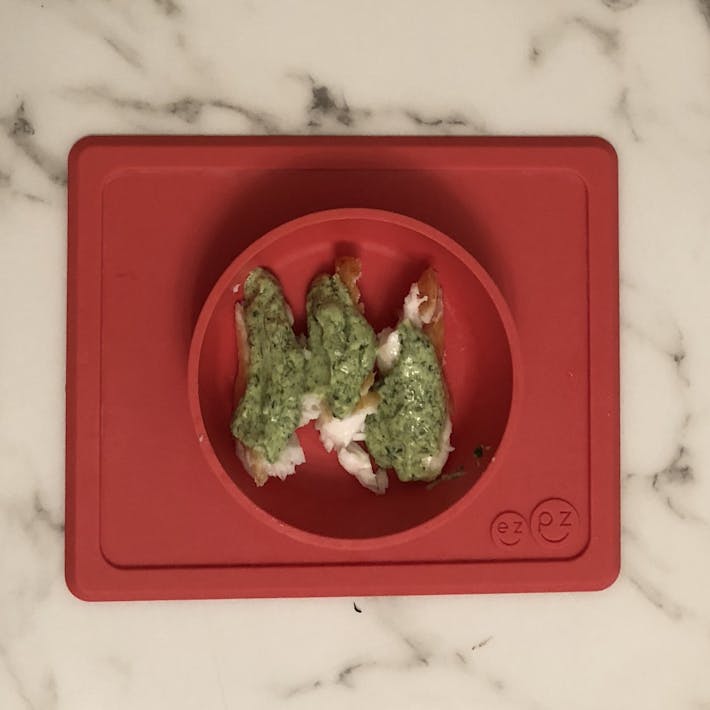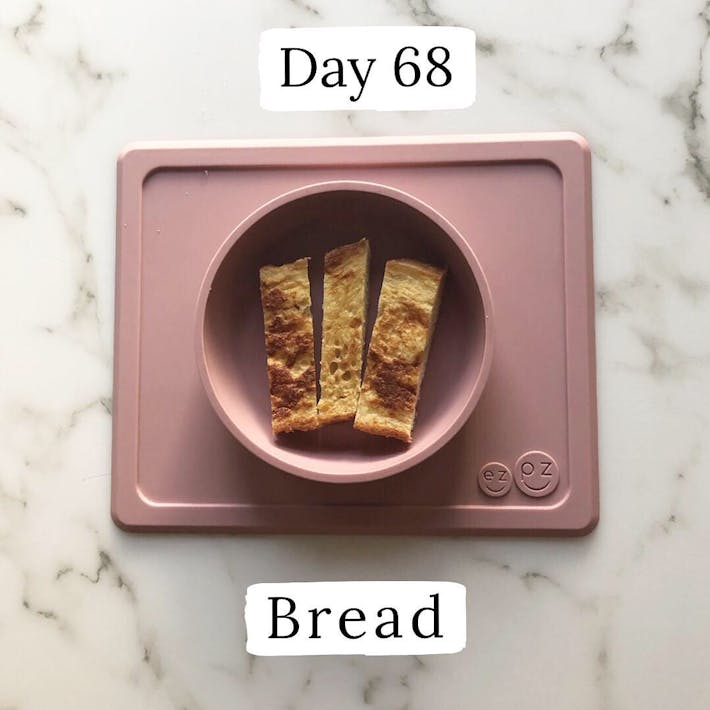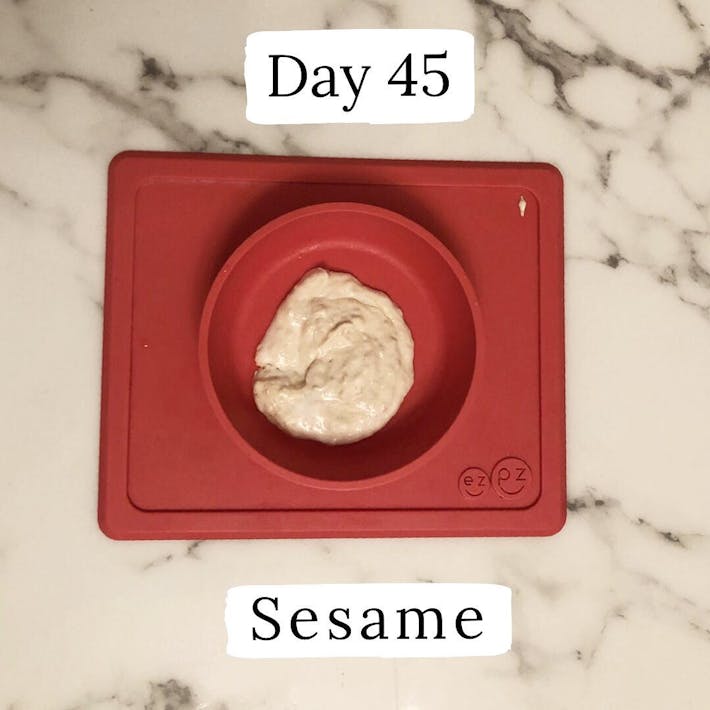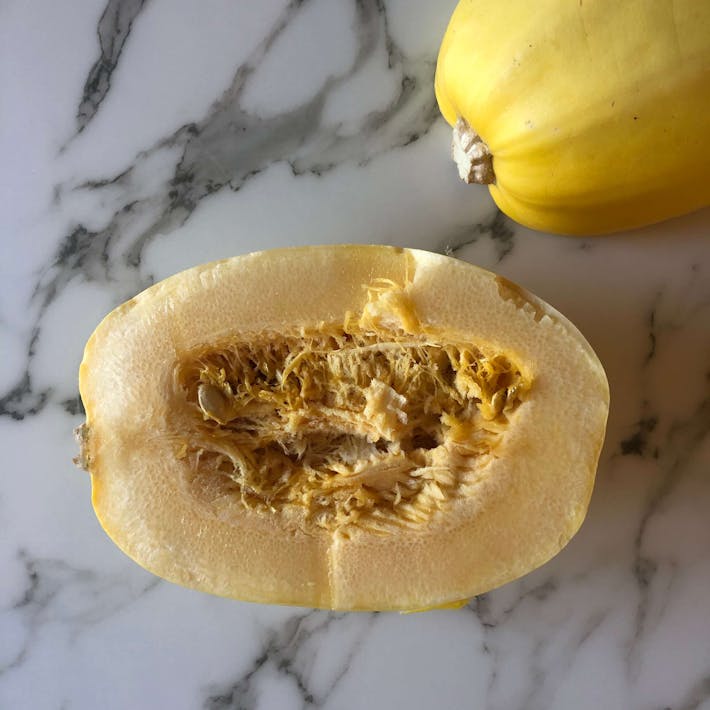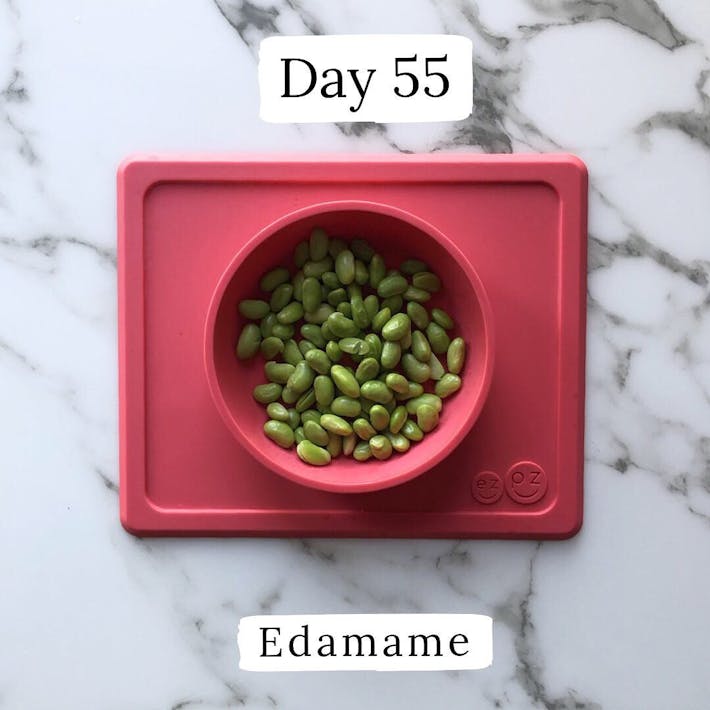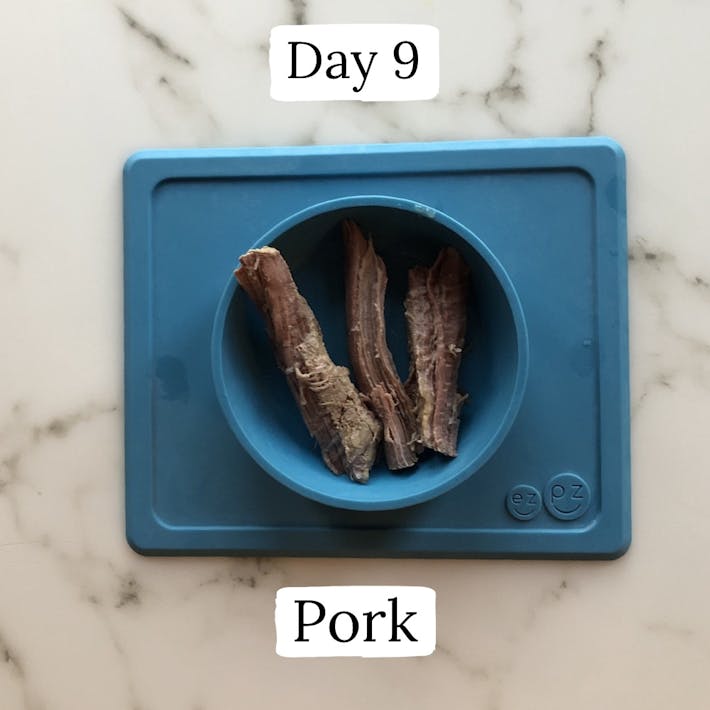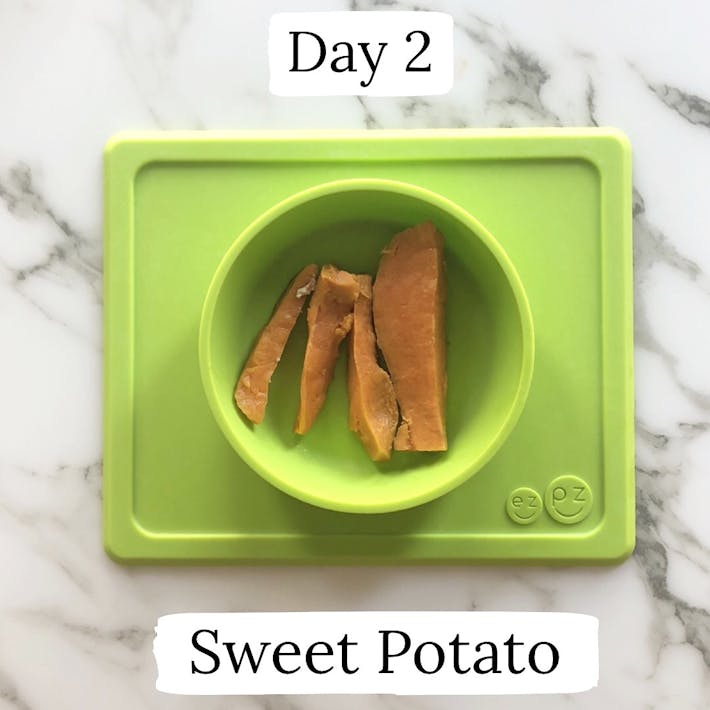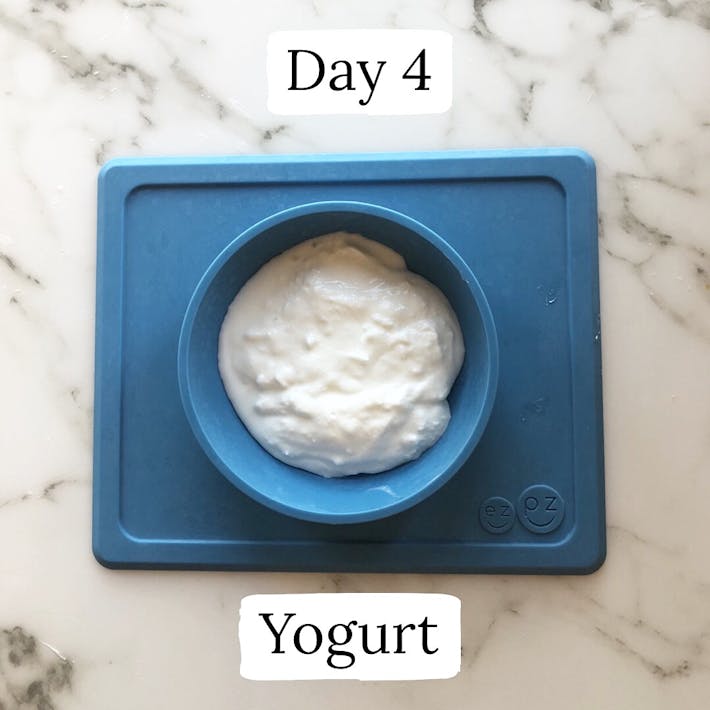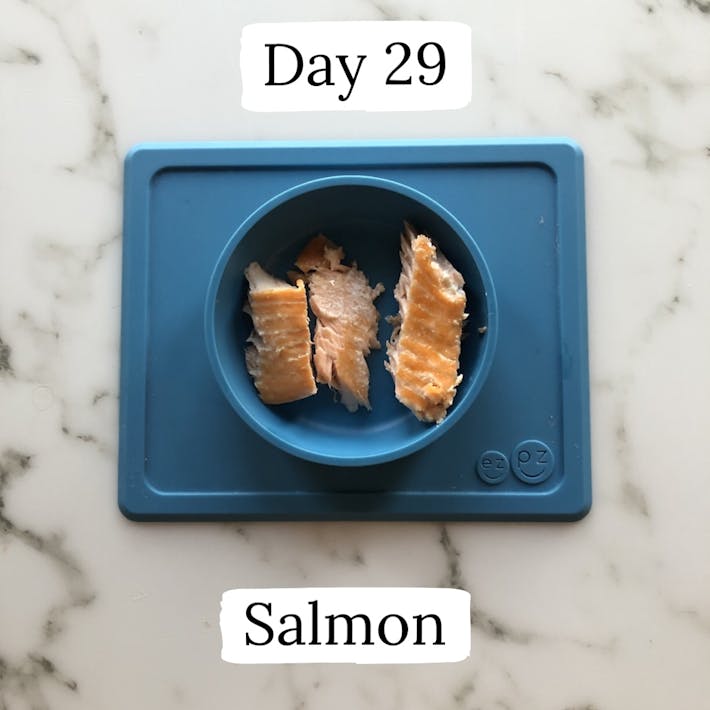Written by Katie Ferraro, MPH, RDN
Disclaimer: The information in this post was written by a dietitian specializing in infant feeding and baby-led weaning. The information in this post is not intended to replace the medical advice of your provider. This is not a sponsored post. This post does contain affiliate links.
If you are a fan of Trader Joe’s grocery store and you have a baby in your house, you are in luck. There are so many TJ’s foods your baby can eat. In this article I will share 10 foods from Trader Joe’s that you can safely offer to your baby when you are starting solid foods.
This is not a “first 10 foods” or the only 10 foods you could purchase at Trader Joe’s, by any means! It is simply a list of 10 foods from TJ’s that you might NOT have thought your baby can eat.
Keep in mind that the greater the number of foods, flavors, tastes and textures that you can expose your baby to early and often - the easier it will be to raise an independent eater (and prevent picky eating!)
So here goes...10 Trader Joe’s foods you can buy and serve your baby safely (especially if you’re doing baby-led weaning)
1. FRESH BASIL
I sometimes go to Trader Joe’s just to get the basil. It’s big, it’s cheap, it’s amazing and fragrant.
And what does a baby do with fresh basil leaves? Well, definitely don’t serve the leaves to the baby! We leave raw leafy foods like spinach and kale and basil until later. They can be a choking hazard and there is an easier way to use basil for babies.
(...but, if you want to learn more about how to safely offer leafy greens to babies, check out this podcast episode: Leafy Greens: 5 Easy Ways For Your Baby Can Safely Eat Greens)
LISTEN TO LEAFY GREENS EPISODE OF BLW PODCAST
Back to the basil…you can use basil in an easy homemade pesto recipe that babies can eat. If you have a food processor - basil, olive oil, lemon juice and a little cheese (optional) or pepper to taste makes a great base for pesto.
You can use the pesto to top pasta (cooked pasta is an easy way to introduce the potentially allergenic food wheat to babies), but it’s also a nice dipper for dry breads and crackers. Dry bread and crackers can be a choking hazard for your baby so always try to moisten them (with a basil pesto if you want!) to be on the safe side.
If you’re interested in some low sodium sauces you can use for dippers and toppers and to moisten other dry foods up for your baby, I have a free feeding guide with 5 LOW SODIUM SAUCES TO MAKE FOODS SAFER and you can download that here.
DOWNLOAD 5 SAUCES FREE FEEDING GUIDE
2. EZEKIEL BREAD
Bread is not your baby’s best friend.
As a dietitian specializing in baby-led weaning, I don’t love bread for early eaters.
Most bread tends to be too high in sodium for babies. And low sodium bread is very dry (one of the things salt does is help baked goods retain moisture…you take out the salt, you lose all the moisture) and dry foods are a choking hazard for babies.
Bread is fine for more experienced eaters, and if you’d like to learn more about safely offering bread to your baby, check out this podcast episode Bread: When Can Babies Safely Eat Bread?
LISTEN TO BREAD EPISODE OF BLW PODCAST
You can find low sodium bread and Ezekiel bread is a good option because it’s available almost everywhere in the United States…but it is dry so don’t forget to use a dipper or a topper to soften things up for your baby and make it easier and safer to swallow.
There are varieties of Ezekiel bread that have 0mg sodium and if you can’t find it in the bakery section of your store, it’s usually in the frozen aisle then.
3. TAHINI
Tahini is sesame seed paste - and sesame is one of the “BIG 9” allergenic foods (...those are the 9 foods that account for about 90% of food allergy).
Offering your baby potentially allergenic foods early and often can help lower the risk of food allergy down the road.
But the problem with tahini is that it’s too sticky on its own. Tahini has the consistency of peanut butter or other nut butters which can easily become lodged on the roof or sides of the baby’s mouth, posing a choking hazard.
You can thin out tahini with breastmilk, formula or unsweetened applesauce. Get it thin enough so it slides off your adult stainless steel spoon and that’s an indicator that it’s thin enough for your baby to safely try from a pre-loaded spoon.
4. SPAGHETTI SQUASH
There are lots of types of squash out there and all of them can be prepared safely for baby-led weaning.
Ideally the final product will be soft pieces of squash cut about the size of your adult pinky finger that your baby can pick up and self-feed.
One squash that you might not use often but do want to check out for is spaghetti squash. Again you can use any squash for early eaters, but spaghetti squash is particularly fun for babies to play with and the unique texture is a new experience too.
I get my spaghetti squash at Trader Joe’s, split it down the middle, scoop the seeds out, lather it up with a ton of olive oil or avocado oil and pop each side face down in a pyrex dish in a 400 degree F oven for about 40-50 minutes or until it shreds easily with a fork.
Adding the extra oil is a good way to get a little extra fat in your baby. Fruits and vegetables are fine, but babies also need fat to help their still developing brains. I look for the oils that are mostly unsaturated sources of fat like peanut oil, avocado and olive oil.
To learn more about which types of oils your baby can try, listen to this episode of my podcast: What Type of Oil Should I Use for BLW?
LISTEN TO OILS EPISODE OF BLW PODCAST
5. LAMB
For families that eat meat, meat offers unique nutrition and texture properties for your baby.
I love fatty cuts of meat for babies because they provide more moisture which makes it easier to swallow compared to lean meats.
Lamb is a great meat for babies and it’s quite easy to make a lamb roast safe for baby-led weaning.
My mantra with cooked meats for babies is, “If you can shred the meat between your finger and your thumbs, then it’s safe for your baby to eat with their gums.”
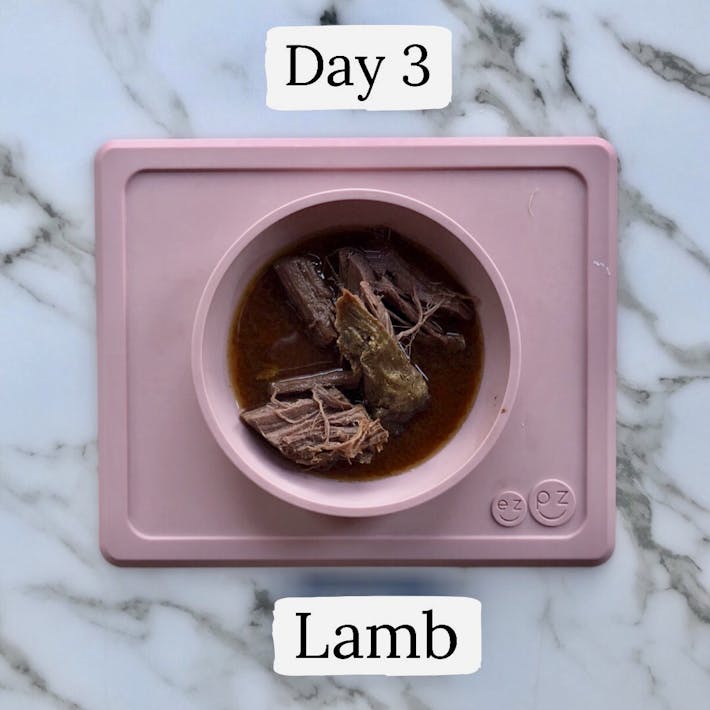
When it comes to lamb, I’ve had much more success for baby-led weaning with leg of lamb roasts (bone in or boneless, doesn’t matter) than with lamb chops or lamb stew meat. The former gets soft and shreddable and is safe for babies to eat.
I love the lamb roast from Trader Joe’s. I pop it in a slow cooker with low sodium broth, or even a little water with seasoning (not salt) and a few hours later it’s ready to go.
You want to have soft, shredded strips of meat like lamb that even babies without teeth can benefit from gnawing or chomping on.
Babies are not actually eating a ton of the meat or food early on when they start solid foods…but getting in the habit of preparing high iron foods like lamb - and letting your baby learn how to eat them is a good idea if your family does eat animal foods.
6. EDAMAME
Edamame are boiled soybeans.
Soy is another one of those BIG 9 allergenic foods, so we want to offer it early and often.
Now I don’t do edamame for earlier eaters because edamame are small pieces of soybean that requires a pincer grasp to pick up. Your baby will not have their pincer grasp at 6, 7 or even 8 months of age - so for earlier eaters, tofu is a safer way to offer your baby soy.
But once your baby does get their pincer grasp, cook edamame until soft and let them practice picking it up and self-feeding.
See how this brand of edamame at Trader Joe’s has only 5mg sodium?
That’s a great product for babies. There are no hard and fast rules about sodium for babies, but my general rule of thumb is that I look for foods with less than 100 mg sodium per serving if I’m going to serve it to my baby.
Just be on the lookout because there are some brands of shelled edamame that add sodium beforehand and you want to steer clear of those for the earlier eaters.
7. LOW SODIUM BROTH
Trader Joe’s has a great variety of low sodium broth options. You can get low sodium beef broth, low sodium chicken broth and low sodium vegetable broth there.
Low sodium broths are great for slow cooking or roasting those high iron meats that babies can eat at 6 months of age or older. You want to avoid tough pieces of meat for babies early on...so cooking your meat low and slow in a low sodium broth is a great way to tenderize and get soft strips babies can self-feed.
Notice how the Trader Joe’s organic chicken broth has 90 mg sodium per cup whereas the vegetable one has 140 mg per cup. It’s not a big deal of a difference - and no way is a baby drinking a whole CUP of broth...but it is a good idea to get in the habit of reading sodium on labels and choosing the lowest possible for your baby.
A little salt is ok but you don’t want the baby to become accustomed to tasting the salt and not the flavor of the food. Overexposure to sodium early on can lead babies to have a preference for salty (less healthy) foods down the road.
To learn more about sodium guidelines for babies, have a listen to this episode of my BABY-LED WEANING MADE EASY podcast: Sodium Limits for Babies Around the World
LISTEN TO SODIUM LIMITS EPISODE OF BLW PODCAST
8. SWEET POTATOES
Sweet potatoes are one of the easiest simple starter foods to prepare for baby-led weaning.
They are affordable, easy to cook, and when you remove the skin, you can easily cut cooked sweet potato into the shape of your adult pinky finger and offer those pieces to your baby to self-feed.
Sometimes sweet potatoes are actually TOO EASY to offer to your baby, and families get stuck in a rut offering the same simple starter foods like avocado, banana and sweet potato.
If that is happening to you, I have a free feeding guide called 10 EASY STARTER FOODS FOR BABY-LED WEANING with ideas of other foods that are easy to safely prep for early eaters.
DOWNLOAD 10 STARTER FOODS FREE FEEDING GUIDE
Of course you can buy sweet potatoes at lots of stores, I just find that Trader Joe’s tends to have a more consistent stock (even outside of the fall months when they’re not available at many other stores). I also like that their sweet potatoes are uniform in size and so they tend to cook more evenly.
To prepare sweet potatoes for babies, turn your oven on to 400 degrees F, scrub the sweet potatoes and plop them on a baking sheet. Bake for about an hour, or until tender. Then let cool until ALMOST cool but not entirely and peel the skin off. (It’s much harder to remove the skin once the potato has entirely cooled). Then cut the cooled sweet potato into shapes about the size of your adult pinky finger (or a fat french fry) and serve to baby.
9. PLAIN YOGURT
One of the most confusing things about starting solid foods for babies is the recommendation about babies having milk and dairy. It is true that babies should not have fluid cow’s milk in place of breastmilk and/or formula until the baby has reached 1 year of age.
…but it is not true that babies can’t have dairy foods like yogurt or some milk when it is used as an ingredient or elsewhere in the diet (...just not in lieu of breastmilk and/or formula).
In fact, milk protein is one of those Big 9 allergenic foods - and there is some data that introducing milk protein early and often to your baby may help prevent milk allergy down the road.
One of the easiest ways to introduce cow’s milk protein is by offering baby plain, whole milk yogurt. Plain because that means it does not contain added sugars (even seemingly healthy “fruit yogurts” are often chock full of added sugars). Whole milk yogurt is also best because of the higher fat content which is helpful for that still-developing baby brain. (Steer clear of reduced fat dairy products until after 2 years.)
So how do you do yogurt if you’re doing baby-led weaning? Well you can always let your baby eat with his hands. Yogurt is inherently messy (we only do yogurt for babies on bath day at my house!)
…but you can also honor the self-feeding principles of baby-led weaning and offer naturally puree texture foods like plain yogurt and we do this using the pre-loaded spoon approach.
You put the yogurt on the spoon and then put the spoon in the baby’s hand who can guide it to their mouth and learn to eat by spoon this way.
The spoons that I use for baby-led weaning are the Tiny Spoons from ezpz. They were designed by a speech language pathologist and infant feeding expert and are perfect for helping independent eaters learn how to self-feed. You can get 10% off at ezpzfun.com with my affiliate discount code KATIE10.
SHOP EZPZ FEEDING GEAR - CODE: KATIE10
10. SALMON
Salmon is a fatty fish that babies can safely eat. Yes of course you always want to do a spot check for bones, but salmon is so easy to roast and season and babies love trying out this soft texture and unique new flavor.
Fish is also one of the Big 9 allergenic foods, so it’s one of the foods you want to offer early and often.
With the allergenic foods, I don’t recommend introducing 2 or more new allergenic foods at the same time. You want to space them out a bit so you can observe for any potential allergic reaction.
If your baby is going to have an allergic reaction to food it will occur within minutes and up to no more than 2 hours following ingestion…so you do not need to wait 3-5 days between introducing new foods.
100 FIRST FOODS PROGRAM
In some of the photos inside of this post you’ll notice the overhead bowl pictures of the foods are numbered by days. These are foods from my 100 FIRST FOODS™ approach to baby-led weaning.

In 2016 I created the original 100 FIRST FOODS approach to baby-led weaning where you get your baby to eat 100 safe baby-led weaning foods before they turn one.
The program is called BABY-LED WEANING with Katie Ferraro and it is a step-by-step digital program designed to help your baby safely learn how to eat over 100 foods before turning one with education, guidance and support every step of the way.
Here’s what you get when you join the BABY-LED WEANING with Katie Ferraro program:
- Every module and lesson is organized and streamlined to move your baby through the three distinct phases of baby-led weaning, so that by age 1 almost all of your baby’s nutrition will successfully be coming from food
- A strategic roadmap for helping your baby master trickier textures, safely eat allergenic foods and gain exposure to a wide variety of foods to help lower the risk of picky eating and save yourself valuable time, money and sanity while doing so
- Over 100 combination food recipes for Phase 2 of baby-led weaning…these are recipes your whole family will love so that you don’t have to worry about what your baby is having for dinner tonight, because the recipes are right there
- Support resources, including grocery lists, meal plans, checklists and cheat sheets designed to help you and your baby achieve important feeding and nutrition milestones so that you don’t have to go hunting and pecking all over the internet to figure it out on your own
- Access to the original 100 FIRST FOODS content library with instructions, videos, resources and recipes on how to safely make every food for your baby’s current age and stage, so that you’ll never wonder if you’re doing baby-led weaning the right way
- An easy to follow, evidence-based plan for helping your baby safely eat over 100 foods before turning 1 so that you can enjoy this next phase while your friends and family comment on what an amazing eater your baby is
Sign up to start pushing your baby’s palate TODAY and help your baby eat 100 foods before turning 1!
JOIN KATIE’S 100 FIRST FOODS BLW PROGRAM
ABOUT THE AUTHOR:
Katie Ferraro, MPH, RDN is a registered dietitian, college nutrition professor and mom of 7. She specializes in baby-led weaning and is the creator of the original 100 FIRST FOODS™ program. Katie hosts the top-rated parenting podcast BABY-LED WEANING MADE EASY and runs the baby-led weaning YouTube channel and @babyledweanteam Instagram account. Her BABY-LED WEANING with Katie Ferrao digital program is the go to resource for exactly how to start solid foods safely with baby-led weaning and to help your baby eat 100 safe, baby-led weaning foods before turning one.
